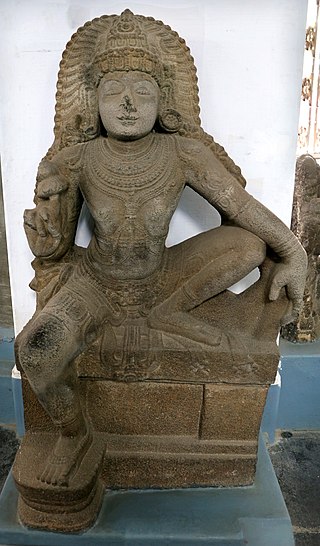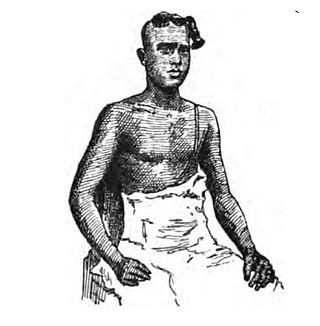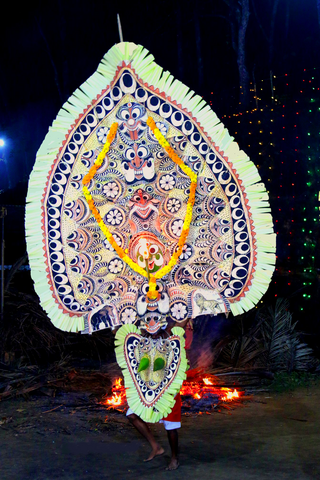
Āśān is a Malayalam and Tamil surname and title that means teacher or guide. [1]

Āśān is a Malayalam and Tamil surname and title that means teacher or guide. [1]
Aasaan is a simplification of the Sanskrit term "Acharya" to denote "teacher/guru".[ citation needed ]
They acted as the media for Sanskritisation and literacy to Non-Brahmins. [2] Ezhuthuassan was another name in which they were known at certain regions of Kerala. Till the second half of twentieth century the AsanKalari or Ezhuthu Kalari or Ezhuthu palli (village schools) were common in each village as it was conducted in many families of Ganaka in Travancore. [3] [4]
The female members of Ganaka were generally addressed as Asatti or Asaatti, because they too had engaged in teaching 3Rs to pupil. [5] [6]
For the last two centuries, it has not been uncommon to adopt this title by many learned people from other castes (Nair, Ezhava, Thiyya, Christian Nadar) as well. Eventually, the common usage of the term Asan gradually lost its original meaning as a venerated symbolic representation for teachers, as it is found used in every parlance without any significance to its meaning.

Malayalam is a Dravidian language spoken in the Indian state of Kerala and the union territories of Lakshadweep and Puducherry by the Malayali people. It is one of 22 scheduled languages of India. Malayalam was designated a "Classical Language of India" in 2013. Malayalam has official language status in Kerala and Puducherry (Mahé), and is also the primary spoken language of Lakshadweep and is spoken by 34 million people in India. Malayalam is also spoken by linguistic minorities in the neighbouring states; with a significant number of speakers in the Kodagu and Dakshina Kannada districts of Karnataka, and Kanyakumari and Nilgiris district of Tamil Nadu. It is also spoken by the Malayali Diaspora worldwide, especially in the Persian Gulf countries, due to the large populations of Malayali expatriates there. They are a significant population in each city in India including Mumbai, Bengaluru, Delhi, Kolkata, Pune etc. Malayalam is closely related to the Tamil language.

Malayalam, the lingua franca of the Indian state of Kerala and the union territories of Lakshadweep and Puduchery, is one of the six classical languages of India. Malayalam literature comprises those literary texts written in Malayalam, a South-Dravidian language spoken in the Indian state of Kerala. The first travelogue in any Indian language is the Malayalam Varthamanappusthakam, written by Paremmakkal Thoma Kathanar in 1785. Malayalam literature has been presented with 6 Jnanapith awards, the second-most for any Dravidian language and the third-highest for any Indian language.

Kalaripayattu is an Indian martial art that originated in Kerala, a state on the southwestern coast of India. Kalaripayattu is known for its long-standing history within Indian martial arts, and is the oldest surviving martial art in the world.

Mahakavi Kumaran Asan was a poet of Malayalam literature, Indian social reformer and a philosopher.He is known to have initiated a revolution in Malayalam poetry during the first quarter of the 20th century, transforming it from the metaphysical to the lyrical and his poetry is characterised by its moral and spiritual content, poetic concentration and dramatic contextualisation. He is one of the triumvirate poets of Kerala and a disciple of Sree Narayana Guru. He was awarded the prefix "Mahakavi" in 1922 by the Madras university which means "great poet".

Thunchaththu Ramanujan Ezhuthachan was a Malayalam devotional poet, translator and linguist. He was one of the prāchīna kavithrayam of Malayalam literature, the other two being Kunchan Nambiar and Cherusseri. He has been called the "Father of Modern Malayalam", the "Father of Modern Malayalam Literature", and the "Primal Poet in Malayalam". He was one of the pioneers of a major shift in Kerala's literary culture. His work is published and read far more than that of any of his contemporaries or predecessors in Kerala.

Chattampi Swamikal was a Hindu sage and social reformer whose thoughts and work influenced the launching of many social, religious, literary and political organisations and movements in Kerala and gave voice to those who were marginalised. Chattampi Swamikal denounced the orthodox interpretation of Hindu texts citing sources from the Vedas. Swamikal strived to reform the heavily ritualistic and caste-ridden Hindu society of the late 19th century Kerala. Swamikal also worked for the emancipation of women and encouraged them to come to the forefront of society. Swamikal promoted vegetarianism and professed non-violence (Ahimsa). Swamikal believed that the different religions are different paths leading to the same place. Chattambi Swamikal led a wandering life like an adutha and throughout his intellectually and spiritually enriched life maintained many friends from different regions of Kerala. He authored several books on spirituality, history, and language staying with these friends.
A kalari is a gymnasium or training space primarily associated with the martial art of Kalaripayattu. The word kalari comes from Malayalam. In the past, village schools in Kerala, typically run by the traditional astrologer families, were known by the name kalari or Ezhuthu Kalari.

Kotas, also Kothar or Kov by self-designation, are an ethnic group who are indigenous to the Nilgiris mountain range in Tamil Nadu, India. They are one of the many tribal people indigenous to the region.. Todas and Kotas have been subject to intense anthropological, linguistic and genetic analysis since the early 19th century. Study of Todas and Kotas has also been influential in the development of the field of anthropology. Numerically Kotas have always been a small group not exceeding 1,500 individuals spread over seven villages for the last 160 years. They have maintained a lifestyle as a jack of all trades such as potters, agriculturalist, leather workers, carpenters, and black smiths and as musicians for other groups. Since the British colonial period they have availed themselves of educational facilities and have improved their socio-economic status and no longer depend on the traditional services provided to make a living. Some anthropologists have considered them to be a specialized caste as opposed to a tribe or an ethnic group.
Vellalar is a group of castes in the Indian states of Tamil Nadu, Kerala and northeastern parts of Sri Lanka. The Vellalar are members of several endogamous castes such as the numerically strong Arunattu Vellalar, Chozhia Vellalar, Karkarthar Vellalar, Kongu Vellalar, Thuluva Vellalar and Sri Lankan Vellalar.

Ayyanar is a Tamil deity venerated in South India and Sri Lanka. His worship is prevalent among the Dravidian peoples. Some studies suggest that Ayyanar may have also been worshipped in Southeast Asian countries in the past. He is primarily worshipped as one of the guardian folk deities of Tamil Nadu. The temples of Ayyanar in the countryside are usually flanked by gigantic and colourful statues of him and his companions riding horses or elephants.

The Nambudiri, also transliterated as Nampoothiri, Nambūdiri, Namboodiri, Namboothiri and Nampūtiri, are a Malayali Brahmin caste, native to what is now the state of Kerala, India, where they constituted part of the traditional feudal elite. As the highest ranking caste in Kerala, they owned a large portion of the land in the region of Malabar until the Kerala Land Reforms starting in 1957.

The Ezhavas are a community with origins in the region of India presently known as Kerala, where in the 2010s they constituted about 23% of the population and were reported to be the largest Hindu community. The Malabar Ezhava group have claimed a higher ranking in the Hindu caste system than do the others, although from the perspective of the colonial and subsequent administrations they were treated as being of similar rank.

The Rowther are originally a Tamil community from the Indian state of Tamil Nadu and Kerala. they were converted to Islam by the preacher Nathar Shah. Even after conversion they retained their caste name. they were elite cavalrymen of the Chola and Pandya kingdoms. They were traditionally a martial clan like the Maravars, and constitute large part of the multi-ethnic Tamil Muslim community. Ravuttars have also been found as Tamil polygars, zamindars and chieftains from the 16th to 18th centuries. The traditional homelands of the Ravuttars were in the interior of Southern Tamilakam.
Kaniyar is a caste from the Indian state of Kerala. There are regional variations in the name used to define them. They are listed under the Other Backward Communities (OBC) by the Kerala Government.

Peringottukara is a village in the western coastal side of India, located on the western side of Thrissur district, Kerala. The village is much famous for Vishnumaya Temples. Peringottukara village includes kizhakkumuri, vadakkumuri, and peringottukara center. Peringottukara village has main two junctions, the four-way junction, and three-way junction. The four-way junction has a petrol pump, three-star hotel, hypermarket, nationalized bank, Co-operative banks, and grocery stores. Peringottukara 3 way junction also has the same facilities. There are Chathan Seva temples at Peringottukara, such as Kanadi Kavu, Avanangattu Kalari, and Devasthanam. Among these Avanangattu Kalari is the biggest and oldest Temple. The biggest building, Shiva Parvathy Vishnumaya Terracotta Statue in Kerala is situated in front of the Peringottukara devasthanam, Its height is 52 ft.

Padayani, also known Padeni, is a traditional folk dance and a ritual art from the central portion of the Indian state of Kerala. A ceremonial dance involving masks, it is an ancient ritual performed in Bhagavati temples. The dance is performed in honor of Bhadrakaali. Meaning, a 'row of warriors', Padayani is an art form that blends all music, dance, theatre, satire, facial masks, and paintings. It is part of worship of Bhadrakali and is staged in temples dedicated to the goddess from mid-December to mid-May. Padayani is unique to central Travancore, comprising the Pathanamthitta and Kottayam districts of Kerala. It is also performed in adjoining regions of Kollam, Alappuzha districts.
Ezhuthu Kalari, a Malayalam term refers to the old traditional village schools in Kerala. These institutions were the major centers for initiating elementary education. Most of the children in the past had to attend these centres for learning 3Rs. It had been known by other names as well, such as Ezhuthu pally or Asan Kalari or Pallikkoodam. Ezhuthu Kalari were believed to be evolved from the ancient traditions of Gurukula system of schooling. Teachers of these schools were addressed by the name Asan or Ezhuthu Asan. Ezhuthupally meaning schools on Shree Budda's period

Parichamuttu Kali is an Indian martial-arts dance form of Kerala practiced by the Saint Thomas Syrian Christians who trace their origins to the evangelistic activity of Thomas the Apostle in the 1st century. It is performed by men bearing swords and shields and follows the movements and steps of Kalarippayattu. This dance is closely related to Margam Kali. Parichamuttu Kali was also performed by Harijans.
Pallikoodam or Ezhuthupally Pally is a word in Malayalam and Tamil that denotes a school. These were mostly village schools run by individual teachers and were distinct from Kalaris that taught martial arts.
Kondaikatti Velaalar or Thondaimandala Mudaliar is a Tamil caste in south India. Historically, they were a caste of non-cultivating land-holders and some of them were administrators under various south Indian dynasties. Their original homeland was Thondaimandalam and from there they spread to other areas in south India and northeastern parts of Sri Lanka. Since they historically used the Mudaliar title, they are sometimes referred to as Thondaimandala Mudaliar. However, Kathleen Gough considers them to be a separate subcaste of the Thondaimandala Mudali, as does Susan Neild.